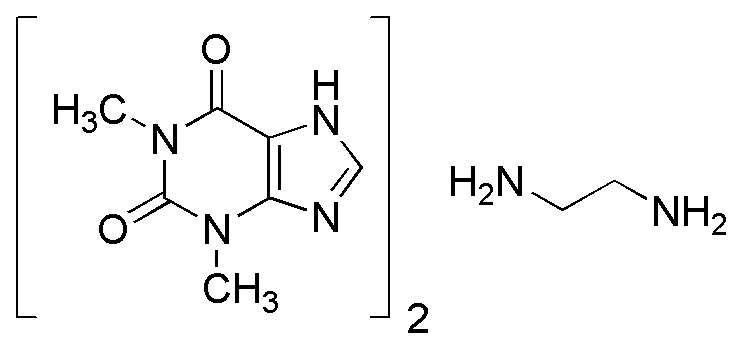Aminophylline is widely utilized in research focused on:
- Respiratory Medicine: It is commonly used as a bronchodilator to treat asthma and chronic obstructive pulmonary disease (COPD), helping to relax the muscles in the airways and improve breathing.
- Cardiovascular Research: Researchers explore its effects on heart function, particularly in cases of congestive heart failure, where it may help improve blood flow and reduce symptoms.
- Pharmaceutical Development: Aminophylline serves as a model compound in drug formulation studies, allowing scientists to investigate the release profiles of various medications.
- Veterinary Medicine: It is also used in veterinary practices to treat respiratory issues in animals, showcasing its versatility across species.
- Clinical Trials: The compound is often included in clinical studies to assess its efficacy and safety in various therapeutic contexts, providing valuable data for future treatments.
Informations générales
Propriétés
Sécurité et réglementation
Applications
Aminophylline is widely utilized in research focused on:
- Respiratory Medicine: It is commonly used as a bronchodilator to treat asthma and chronic obstructive pulmonary disease (COPD), helping to relax the muscles in the airways and improve breathing.
- Cardiovascular Research: Researchers explore its effects on heart function, particularly in cases of congestive heart failure, where it may help improve blood flow and reduce symptoms.
- Pharmaceutical Development: Aminophylline serves as a model compound in drug formulation studies, allowing scientists to investigate the release profiles of various medications.
- Veterinary Medicine: It is also used in veterinary practices to treat respiratory issues in animals, showcasing its versatility across species.
- Clinical Trials: The compound is often included in clinical studies to assess its efficacy and safety in various therapeutic contexts, providing valuable data for future treatments.
Documents
Fiches de données de sécurité (FDS)
La FDS fournit des informations de sécurité complètes sur la manipulation, le stockage et l’élimination du produit.
Spécifications du produit (PS)
Le PS fournit une description complète des propriétés du produit, notamment sa composition chimique, son état physique, sa pureté et les exigences de stockage. Il détaille également les plages de qualité acceptables et les applications prévues du produit.
Certificats d'analyse (COA)
Recherchez des certificats d'analyse (COA) en saisissant le numéro de lot du produit. Les numéros de lot et de lot se trouvent sur l'étiquette d'un produit, après les mots « Lot » ou « Lot de fabrication ».
Numéro de catalogue
Numéro de lot/série
Certificats d'origine (COO)
Ce certificat d'exploitation confirme le pays dans lequel le produit a été fabriqué, et détaille également les matériaux et composants utilisés et s'il est issu de sources naturelles, synthétiques ou autres sources spécifiques. Ce certificat peut être requis pour les douanes, le commerce et la conformité réglementaire.
Numéro de catalogue
Numéro de lot/série
Fiches de données de sécurité (FDS)
La FDS fournit des informations de sécurité complètes sur la manipulation, le stockage et l’élimination du produit.
DownloadSpécifications du produit (PS)
Le PS fournit une description complète des propriétés du produit, notamment sa composition chimique, son état physique, sa pureté et les exigences de stockage. Il détaille également les plages de qualité acceptables et les applications prévues du produit.
DownloadCertificats d'analyse (COA)
Recherchez des certificats d'analyse (COA) en saisissant le numéro de lot du produit. Les numéros de lot et de lot se trouvent sur l'étiquette d'un produit, après les mots « Lot » ou « Lot de fabrication ».
Numéro de catalogue
Numéro de lot/série
Certificats d'origine (COO)
Ce certificat d'exploitation confirme le pays dans lequel le produit a été fabriqué, et détaille également les matériaux et composants utilisés et s'il est issu de sources naturelles, synthétiques ou autres sources spécifiques. Ce certificat peut être requis pour les douanes, le commerce et la conformité réglementaire.


